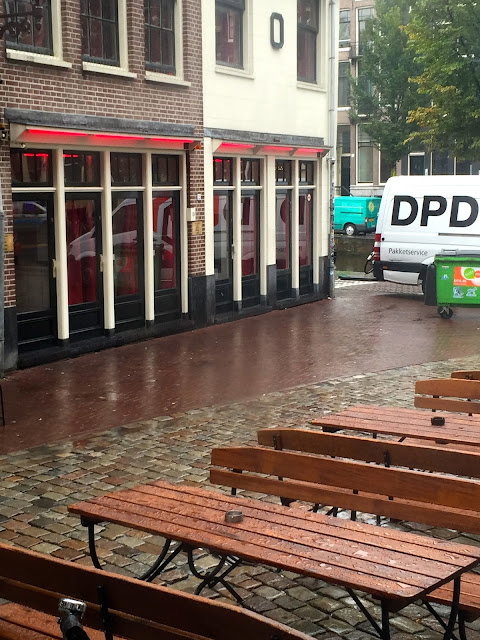Then, again, this is Amsterdam. Prostitution is legal and much of the 17th-century historic center remains intact--the two (seemingly) cultural opposites are bound to intersect somewhere in town.
Oude Kerk (Old Church) is not only the oldest church in Amsterdam, it is the oldest building in the entire city. It was established in 1306, over 800 years ago, in the middle of medieval Amsterdam. Back then, Amsterdam wasn't really a city at all, but a settlement, and was still 300 years away from constructing its famous canal ring or tulip mania or Rembrandt or the Dutch India Company.
But that was then, and this is now . . . it was not the least surprising to find this inlaid sculpture outside the front doors of Oude Kerk.
The ceiling of the church is like the inverted hull of a ship. See what I mean in the drawing below?
The barrel-vaulting allowed for much-needed light to compete with the grey skies of Amsterdam. It's not surprising that ship-building techniques were used in building architecture, since trading and sea-faring were such a big part of Dutch culture at the time.
Here's not such a great photo of the barrel vaulting:
Originally, Oude Kerk was a Catholic church, but when Amsterdam joined in rebellion against Spanish rule in the 1500's, it became Protestant. Like so many other converted churches, this meant the Puritans white-washed the interior of the church, covering up centuries-old paintings, frescoes, and other iconography. Here are the remains of paintings on the vaulted ceilings, which were uncovered during various restorations:
I stood in the window shown above to take a photo of the outside view.
Now look below. Do you see what I see? As I said, this church is literally located in the heart of the Red Light District. The red neon lights are illuminated, which means the brothel is open for business, but the curtains are drawn indicating the women working there are busy with a customer.
You can always find a cool floor in old churches.
Even hundreds of years ago, the Dutch had a knack for languages. Here's a tombstone inscribed in English, Dutch, and Latin . . . van Holy.
Rembrandt's beloved wife-muse-model, Saskia, is the most famous person to have been buried in the church:
Stairway to heaven:
The Dutch aren't particularly known for their sarcasm or irony, they are just too direct to do more than take what's being said at face value. BUT, they do like toying with commonly upheld social values or community morals. It's cute to see that this was the case even 600 years ago. The carving below, from 1480, is the Dutch version of "money doesn't grow on trees." In other words, "you can't poop money."
Seafaring was always on the mind:
I really, really want a collection of old Dutch Master-ish paintings:
I'm positively in love with the irreverent manner in which the guide to this church is written. The tongue-and-cheek tone of the pamphlet is totally in keeping with the location of the church in a less-than-holy neighborhood and in keeping with the personality of the Dutch.
I know no one will actually read this, but if you ever find yourself planning a trip to Amsterdam, enjoy it as a pre-read.
DS and I lunched at a restaurant around the corner, called Den Waag. This building is also super old, built in 1488. At one time, Amsterdam was a walled city, and this building is the only surviving gate house from wall, where people could pass in and out of the city. Once the wall came down, the building served as a weigh house for all the exotic items merchants were bringing back from the Orient.
Below, the backside of the gate house is pictured. Many of the guilds had offices here, including the surgeons guild. The latter performed one public dissection per year, on the cadaver of an executed criminal. In 1632, Rembrandt attended one of these dissections in one the rooms you can see below. He captured it in his famous painting, Anatomy Lesson of dr Nicolaes Tulp. This painting now hangs Mauritshuis, an art museum in The Hague.
On that appetizing note, we had our lunch. :-)





















No comments:
Post a Comment